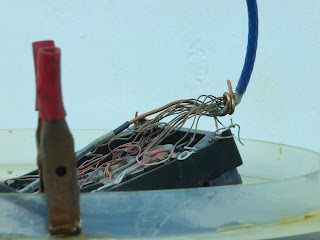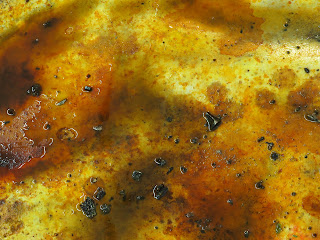Wednesday, October 20, 2010
80GB Apple Hard Drive Dissolution-Precipitation
Nokia Dissolution-Precipitation
Wednesday, May 5, 2010
Electrodissolution of Electronic Waste
Electronic waste is a fast growing environmental problem. Rapid technology change, low initial cost, and planned obsolescence all act to produce an ever growing quantity of e-waste. Due to the high cost of recycling and a reclamation differential present in computer parts, recycling can be expensive and complicated. In places without the limitations and safe guards of environmental laws, the high cost differential and large surplus create a situation where massive amounts of e-waste can be cheaply processed. However, the reclamation waste products, such as heavy metals, are free to enter the ecosystem. For example, the city of Guiyu, China is home to one of the largest e-waste landfills in the world, and because of this it is also one of the most polluted locations in the world. The heavy metal concentrations in the local water supply became so high that the city is forced to import drinking water. Processing involves the extraction of copper, gold, silver and other precious metals by burning, melting and dissolving. Waste products, like lead, cadmium, copper and arsenic, eventually find their way into the surrounding water bodies and soil.
I am interested in simulating the processes that occur naturally in unconfined e-waste landfills. I am specifically interested in the history of heavy metals such as iron, lead, aluminum and copper as they move from mining to electronics to toxic leachate in the ecosystem. Heavy metals are able to “hold” or transport their conceptual history more readily than carbon or oxygen for a number of reasons: they are present in our society in native form, they are highly visibile, and they are relatively simple compared to the highly complex and enumerable organic compounds. By modeling the processes that occur in unregulated “third world” landfills, I hope to 1) gain understanding, through experience, of the effects and consequences of unchecked waste management, 2) partake in the history of these objects and metals, 3) increase awareness of viewers and 4) create a new “end product” (either a 2D painting, photography or film) out of the waste I produce, that is drastically different from the original electronic components.
Friday, October 23, 2009
Leviathan Mine 10/02/2009

Here is a brief history of the site.
"Leviathan Mine is an abandoned open-pit sulfur mine high on the eastern slope of the Sierra Nevada, in Alpine County CA. The mine, 24 miles southeast of Lake Tahoe, has been contaminating a nine-mile stretch of mountain creeks. The Toiyabe National Forest surrounds the site, and there are no permanent residents within several miles. The stream system drains into Nevada about five miles from the mine and enters the picturesque Carson Valley nine miles downstream from the mine. Although there had been some mining activities for copper minerals since the 1860s, major environmental problems originated during the open-pit sulfur mining that occurred from 1951 through 1962. During this period, Anaconda used Leviathan Mine as a source of sulfur to dissolve copper from relatively low-grade ore at a mine near Yerington, NV. In 1962 Anaconda ceased operations and sold the property to a local interest. No significant mining activities have taken place since." EPA
I placed four Gesso covered glass plates and a large piece of canvas in the stream directly downstream from the Superfund (SF) site. The water was clear and there was a small amount of metal oxide/hydroxide sludge on the rock and stream bottom. The Acid Rock Drainage(ARD) remediation upstream at the SF site is inoperable during the winter months, and winter comes early here (see last picture). So, I should get some good color on the plates. I will be collecting the plates and canvas in spring sometime when the site becomes accessible.
In the future I want to gain access (with the EPA and involved parties permission) to the actual site to place some plates in untreated water and water leaving the treatment area. The results would be an excellent illustration of "before-and-after" remediation. This juxtaposition will also put these activities on a larger timeline, simply put the waters of the Leviathan Creek (which captures all the ARD) have changed from "pristine" to horrifically polluted to recovering some of the pristine past. What is the analogous change in human consciousness accompanying these changes? Not only for our "American society" but also for the individual.
This mine is not evil (despite all the brimstone and the name), it was a result of the creation of America. But, at the same time it should not be justified. There is a paradox in all mining, deforestation, hydrocarbon extraction and the like - nobody likes it but everyone wants the benefits of it.
Well, metaphors and analogues and social commentary can abound here but, for now... the work is in process. That is enough.


This is a shot just left of the previous shot. The man made conduits on the lower left are a part of the storm water collection system. The water then flows into the various settling ponds, the red areas on this picture, to be treated.
 Sludge cover rock and glass plate.
Sludge cover rock and glass plate. Plates in Leviathan Creek
Plates in Leviathan Creek
Thursday, July 23, 2009
ELECTRODISSOLUTION: Car Stereo




Friday, June 5, 2009
Turtle Creek near Export, Pa


Chartiers Creek AMD, lower portion


Wednesday, June 3, 2009
AMD on Hardboard: Chartiers Creek #1



Chartiers Creek AMD
This was the first AMD site I began working at, fortunately for me, it ended up having one of the highest dissolved iron contents in the area. I saw this one from route 79 as I was driving around killing time and looking at things. My initial work at the site involved collecting some of the iron oxide and incorporating it into paintings and use as a high fire ceramic glaze component. I later started to immerse paper and other 2D media in the water so I could capture the iron oxidizing.

Location: Near Heidelberg Pa, in Scotts Twp, the drainage is about 100 ft up the East bank of Chartiers Creek, just upstream of the confluence with Toms Run and near, (40.382222, -80.089722).
Date: August 2008
PaDEP Orphan Mine Drainage Site: PA0666
Flow = 81gpm
Water Chemistry (collected on 6/21/2006 by PaDEP)
pH = 6.00
Specific conductivity at 25C = 2410 umhos/cm
Alkalinity = 109 ppm
Hot Acidity = -9 ppm
TDS at 105C = 1830 mg/L
Ferrous Iron = 83.38 ppm
Total Iron = 82.6 ppm
Total Aluminum = 0.2 ppm
Total Manganese = 0.748 ppm
Total Sulfate = 533 ppm









 Canvas in Leviathan Creek - stones were used to hold in in place. Spring snow melt will probably wash the whole this away, but it won't go to far.
Canvas in Leviathan Creek - stones were used to hold in in place. Spring snow melt will probably wash the whole this away, but it won't go to far.